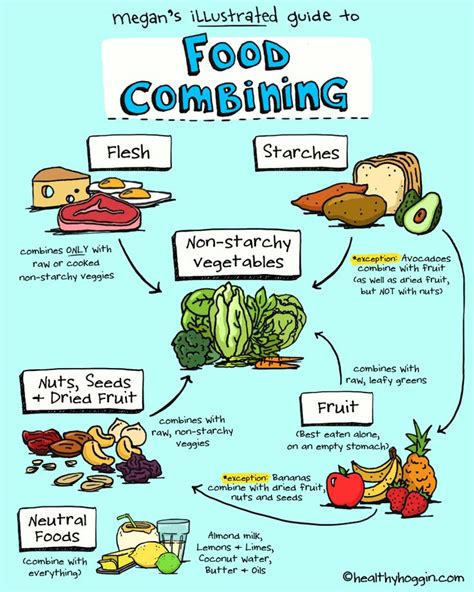Discover the benefits and guidelines of the food combining diet, along with a sample meal plan and considerations for effective results. Understand the science behind this diet.
Understanding the Food Combining Diet
Contents
Understanding the Food Combining Diet
The food combining diet is a nutritional approach that suggests eating certain types of foods together while avoiding consuming others in combination. The main principle behind this diet is that different types of foods require different digestive enzymes to break them down, and combining incompatible foods can lead to digestive issues and nutrient malabsorption.
Proponents of the food combining diet claim that by following specific guidelines, such as not eating proteins and starches together or consuming fruits on an empty stomach, individuals can improve their digestion, increase energy levels, and even promote weight loss. However, some health experts argue that there is limited scientific evidence to support these claims, and the diet may not be suitable for everyone.
There are various guidelines for food combining such as eating fruits on an empty stomach, not combining proteins and starches in the same meal, and avoiding consuming fats with proteins. These rules are based on the idea that certain food combinations can lead to fermentation and putrefaction in the gut, which can contribute to bloating, gas, and other digestive discomforts.
While there is ongoing debate about the effectiveness of the food combining diet, some people may find that they feel better and experience improved digestion by following these principles. It’s important to consider individual tolerance and preferences when deciding whether to incorporate food combining into a regular eating pattern.
Benefits of Food Combining Diet
The food combining diet is a way of eating that focuses on the idea that different foods digest at different rates and require different digestive environments. By combining foods in a specific way, it is believed that you can optimize your digestion and absorption of nutrients, leading to various health benefits.
One of the main benefits of the food combining diet is improved digestion. By separating foods that require different digestive enzymes, such as proteins and carbohydrates, you can reduce the strain on your digestive system and promote more efficient digestion.
Another benefit is increased energy levels. When your digestive system is working more efficiently, you may find that you have more energy throughout the day. This can also lead to improved mental clarity and focus.
Additionally, many people who follow the food combining diet report relief from digestive issues such as bloating, gas, and indigestion. By eating foods in a way that supports optimal digestion, you may experience fewer digestive discomforts.
Guidelines for Food Combining Diet
The food combining diet is based on the principle that different types of foods are best digested and utilized by the body when eaten separately. This diet involves consuming specific types of foods together while avoiding mixing certain food groups. One of the main guidelines for this diet is to avoid combining starchy foods with acidic foods. This means avoiding combining grains such as rice or bread with acidic fruits like oranges or tomatoes. When starchy foods and acidic foods are consumed together, it can lead to digestive issues and poor nutrient absorption.
Another important guideline for the food combining diet is to avoid combining protein-rich foods with starchy foods. This means avoiding meals that include both protein sources such as meat or fish, and starchy foods like potatoes or pasta. The rationale behind this guideline is that protein and starchy foods require different digestive enzymes, and consuming them together can lead to digestive discomfort and bloating.
Additionally, the food combining diet encourages the consumption of vegetables with both protein-rich foods and starchy foods. Vegetables are considered to be neutral and can be easily digested alongside other food groups. Including vegetables with protein or starchy foods can help improve digestion and provide a variety of essential nutrients.
It’s also important to note that the food combining diet recommends consuming fruits on an empty stomach, as they are easily digested and can ferment when combined with other foods. This means that fruits are best consumed as a snack between meals, rather than as part of a larger meal.
Overall, following the guidelines of the food combining diet involves paying attention to the compatibility of different food groups and making intentional choices about how to combine foods for optimal digestion and nutrient absorption.
Sample Food Combining Meal Plan
When following a food combining diet, it is important to plan your meals carefully to ensure proper digestion and absorption of nutrients. Here is a sample meal plan to help you get started on your food combining journey.
Breakfast: Start your day with a delicious fruit salad. Mix together a variety of your favorite fruits such as berries, melons, and citrus fruits. Avoid combining fruits with other food groups, so enjoy your fruit salad on its own.
Lunch: For lunch, opt for a hearty green salad. Load up on leafy greens and add plenty of non-starchy vegetables such as tomatoes, cucumbers, and bell peppers. Top it off with a lean protein source such as grilled chicken or tofu. Dress your salad with a simple vinaigrette made from olive oil and vinegar.
Snack: Enjoy a mid-afternoon snack of crunchy raw vegetables with a side of hummus or guacamole. This combination provides a satisfying crunch and plenty of nutrients without disrupting your food combining principles.
Dinner: For dinner, prepare a balanced meal of steamed or roasted vegetables with a serving of quinoa or lentils. Keep the focus on plant-based foods and avoid combining starchy carbohydrates with proteins for optimal digestion.
Results and Considerations of Food Combining Diet
Results and Considerations of Food Combining Diet
Following a food combining diet can lead to various results and considerations that individuals should be aware of. One major result of this diet is improved digestion. By consuming compatible foods together, the body can more easily break down and absorb nutrients, leading to better overall digestion. Additionally, individuals may also experience weight loss as a result of this diet. Because the focus is on consuming whole, unprocessed foods, many people find that they naturally lose weight as a result of following a food combining diet.
Another consideration of the food combining diet is the potential for nutrient deficiencies. Since this diet emphasizes eating certain foods together and avoiding others, it can be challenging to get a wide range of nutrients from a variety of foods. Individuals following this diet should be mindful of their intake of essential vitamins and minerals to prevent deficiencies.
Moreover, individuals may also experience improved energy levels as a result of the food combining diet. By consuming foods that are easier for the body to digest, individuals may find that they have more energy throughout the day. This can lead to better overall mood and productivity.
Furthermore, there are also considerations for potential food intolerances and sensitivities. While some individuals may thrive on a food combining diet, others may find that certain food combinations do not agree with their bodies. It is important for individuals to pay attention to how their bodies respond to different food combinations and make adjustments as needed.
In conclusion, the results and considerations of the food combining diet can vary from person to person. While some individuals may benefit from improved digestion and energy levels, others may need to be mindful of potential nutrient deficiencies and food sensitivities. It is important for individuals to listen to their bodies and make informed decisions about their diet based on their own unique needs.













